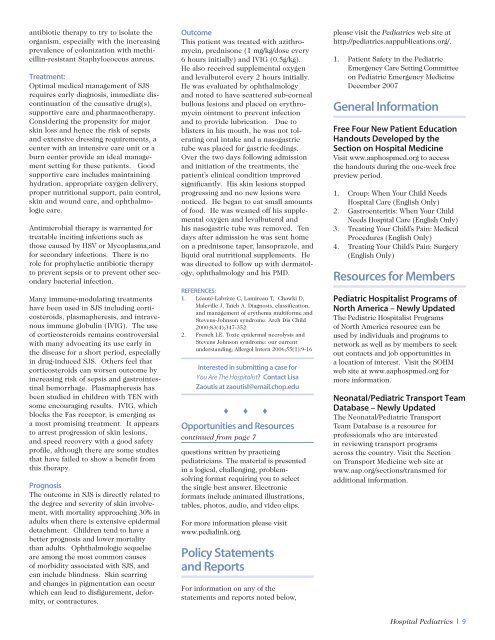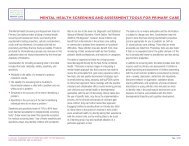Susan Wu, MD, FAAP, Editor - American Academy of Pediatrics
Susan Wu, MD, FAAP, Editor - American Academy of Pediatrics
Susan Wu, MD, FAAP, Editor - American Academy of Pediatrics
Create successful ePaper yourself
Turn your PDF publications into a flip-book with our unique Google optimized e-Paper software.
antibiotic therapy to try to isolate the<br />
organism, especially with the increasing<br />
prevalence <strong>of</strong> colonization with methicillin-resistant<br />
Staphylococcus aureus.<br />
Treatment:<br />
Optimal medical management <strong>of</strong> SJS<br />
requires early diagnosis, immediate discontinuation<br />
<strong>of</strong> the causative drug(s),<br />
supportive care and pharmacotherapy.<br />
Considering the propensity for major<br />
skin loss and hence the risk <strong>of</strong> sepsis<br />
and extensive dressing requirements, a<br />
center with an intensive care unit or a<br />
burn center provide an ideal management<br />
setting for these patients. Good<br />
supportive care includes maintaining<br />
hydration, appropriate oxygen delivery,<br />
proper nutritional support, pain control,<br />
skin and wound care, and ophthalmologic<br />
care.<br />
Antimicrobial therapy is warranted for<br />
treatable inciting infections such as<br />
those caused by HSV or Mycoplasma,and<br />
for secondary infections. There is no<br />
role for prophylactic antibiotic therapy<br />
to prevent sepsis or to prevent other secondary<br />
bacterial infection.<br />
Many immune-modulating treatments<br />
have been used in SJS including corticosteroids,<br />
plasmapheresis, and intravenous<br />
immune globulin (IVIG). The use<br />
<strong>of</strong> corticosteroids remains controversial<br />
with many advocating its use early in<br />
the disease for a short period, especially<br />
in drug-induced SJS. Others feel that<br />
corticosteroids can worsen outcome by<br />
increasing risk <strong>of</strong> sepsis and gastrointestinal<br />
hemorrhage. Plasmapheresis has<br />
been studied in children with TEN with<br />
some encouraging results. IVIG, which<br />
blocks the Fas receptor, is emerging as<br />
a most promising treatment. It appears<br />
to arrest progression <strong>of</strong> skin lesions,<br />
and speed recovery with a good safety<br />
pr<strong>of</strong>ile, although there are some studies<br />
that have failed to show a benefit from<br />
this therapy.<br />
Prognosis<br />
The outcome in SJS is directly related to<br />
the degree and severity <strong>of</strong> skin involvement,<br />
with mortality approaching 30% in<br />
adults when there is extensive epidermal<br />
detachment. Children tend to have a<br />
better prognosis and lower mortality<br />
than adults. Ophthalmologic sequelae<br />
are among the most common causes<br />
<strong>of</strong> morbidity associated with SJS, and<br />
can include blindness. Skin scarring<br />
and changes in pigmentation can occur<br />
which can lead to disfigurement, deformity,<br />
or contractures.<br />
Outcome<br />
This patient was treated with azithromycin,<br />
prednisone (1 mg/kg/dose every<br />
6 hours initially) and IVIG (0.5g/kg).<br />
He also received supplemental oxygen<br />
and levalbuterol every 2 hours initially.<br />
He was evaluated by ophthalmology<br />
and noted to have scattered sub-corneal<br />
bullous lesions and placed on erythromycin<br />
ointment to prevent infection<br />
and to provide lubrication. Due to<br />
blisters in his mouth, he was not tolerating<br />
oral intake and a nasogastric<br />
tube was placed for gastric feedings.<br />
Over the two days following admission<br />
and initiation <strong>of</strong> the treatments, the<br />
patient’s clinical condition improved<br />
significantly. His skin lesions stopped<br />
progressing and no new lesions were<br />
noticed. He began to eat small amounts<br />
<strong>of</strong> food. He was weaned <strong>of</strong>f his supplemental<br />
oxygen and levalbuterol and<br />
his nasogastric tube was removed. Ten<br />
days after admission he was sent home<br />
on a prednisone taper, lansoprazole, and<br />
liquid oral nutritional supplements. He<br />
was directed to follow up with dermatology,<br />
ophthalmology and his P<strong>MD</strong>.<br />
REFERENCES:<br />
1. Léauté-Labrèze C, Lamireau T, Chawki D,<br />
Maleville J, Taïeb A. Diagnosis, classification,<br />
and management <strong>of</strong> erythema multiforme and<br />
Stevens-Johnson syndrome. Arch Dis Child<br />
2000;83(4);347-352.<br />
2. French LE. Toxic epidermal necrolysis and<br />
Stevens Johnson syndrome: our current<br />
understanding; Allergol Intern 2006;55(1):9-16<br />
Interested in submitting a case for<br />
You Are The Hospitalist? Contact Lisa<br />
Zaoutis at zaoutisl@email.chop.edu<br />
♦ ♦ ♦<br />
Opportunities and Resources<br />
continued from page 7<br />
questions written by practicing<br />
pediatricians. The material is presented<br />
in a logical, challenging, problemsolving<br />
format requiring you to select<br />
the single best answer. Electronic<br />
formats include animated illustrations,<br />
tables, photos, audio, and video clips.<br />
For more information please visit<br />
www.pedialink.org.<br />
Policy Statements<br />
and Reports<br />
For information on any <strong>of</strong> the<br />
statements and reports noted below,<br />
please visit the <strong>Pediatrics</strong> web site at<br />
http://pediatrics.aappublications.org/.<br />
1.<br />
Patient Safety in the Pediatric<br />
Emergency Care Setting Committee<br />
on Pediatric Emergency Medicine<br />
December 2007<br />
General Information<br />
Free Four New Patient Education<br />
Handouts Developed by the<br />
Section on Hospital Medicine<br />
Visit www.aaphospmed.org to access<br />
the handouts during the one-week free<br />
preview period.<br />
1.<br />
2.<br />
3.<br />
4.<br />
Croup: When Your Child Needs<br />
Hospital Care (English Only)<br />
Gastroenteritis: When Your Child<br />
Needs Hospital Care (English Only)<br />
Treating Your Child’s Pain: Medical<br />
Procedures (English Only)<br />
Treating Your Child’s Pain: Surgery<br />
(English Only)<br />
Resources for Members<br />
Pediatric Hospitalist Programs <strong>of</strong><br />
North America – Newly Updated<br />
The Pediatric Hospitalist Programs<br />
<strong>of</strong> North America resource can be<br />
used by individuals and programs to<br />
network as well as by members to seek<br />
out contacts and job opportunities in<br />
a location <strong>of</strong> interest. Visit the SOHM<br />
web site at www.aaphospmed.org for<br />
more information.<br />
Neonatal/Pediatric Transport Team<br />
Database – Newly Updated<br />
The Neonatal/Pediatric Transport<br />
Team Database is a resource for<br />
pr<strong>of</strong>essionals who are interested<br />
in reviewing transport programs<br />
across the country. Visit the Section<br />
on Transport Medicine web site at<br />
www.aap.org/sections/transmed for<br />
additional information.<br />
Hospital <strong>Pediatrics</strong> | 9



